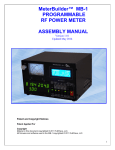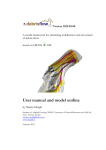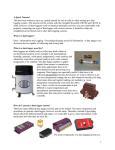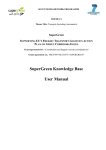Download 3PGPJS User Manual
Transcript
3PGPJS User Manual Peter Sands 39 Oakleigh Av, Taroona, Australia 7053 [email protected] September 2010 Software versions : 3PGPJS vsn 2.7 / 3-PG vsn September 2010 Caveat This is an update of the original pre-3PGPJS 2.4 user guide. I may not have caught all the changes required to the tables of parameters, etc. If so, please accept my apologies and bring any corrections required to my notice Contents Change history for 3PGPJS 4 1. Introductory remarks 5 2. Installation of 3PGPJS 5 3. Running 3-PG 3.1 The 3PGPJS run-types 3.2 General comments on 3PGPJS runs 3.3 Use of keywords 6 6 6 7 4. Specification of 3-PG parameters and options 7 5. The SingleSite run-type 5.1 Mandatory single-site data Climate data Site factor data Initialisation data Specifying dates and ages 5.2 Parameters data block 5.3 Silvicultural events 5.4 Changing parameters and site factors with stand age 5.5 Single-site output Stand development summary Selecting output at specific stand ages Detailed 3-PG output 7 8 8 8 9 9 10 10 11 11 11 12 12 6. Climatic databases 6.1 Climatic variables 6.2 Table format 6.3 Row format 12 12 13 13 7. The Sensitivity analysis run-type 7.1 The sensitivity analysis data block 7.2 Sensitivity analysis output 14 14 14 8. The MultiSite run-type 8.1 Common site data Initialisation of multi-site runs Other common site data 8.2 Multi-site input data 8.3 Silvicultural events 8.4 Site-specific changes to parameters 8.5 Multi-site output 14 14 14 15 15 15 16 16 9. The SiteSeries run-type 16 10. About the worksheets in 3PGpjs.data.xls 10.1 The Parameters worksheet 10.2 Single-site examples 10.3 A sensitivity analysis 10.4 A site-series run 3PGPJS vsn 2.7 16 16 17 17 17 2 September 2010 10.5 The Multi-site examples 10.6 Climate databases 17 18 11. Notes on the 3PGPJS code 11.1 The 3PGpjs.xls workbook 18 18 12. References 19 Table 1. Summary of 3PGpjs keywords and their action 20 Table 2. Soil classes and corresponding parameter assignments 22 Table 3. Description of 3-PG parameters, their 3PGpjs names, and default values for E. globulus 23 Table 4. Names and description of 3PGPJS output variables 25 Table 5. Climate data variables recognised by 3PGpjs 27 Table 6. Names and description of site factors that can be controlled during a sensitivity analysis 27 3PGPJS vsn 2.7 3 September 2010 Change history for 3PGpjs Changes in vsn 2 Mortality is applied monthly; the self-thinning law is satisfied after mortality has been applied. Rainfall interception depends on canopy LAI. The user can modify the radiation conversion in the Penman-Monteith equation. Output can be monthly; the stand can be planted or the simulation initialised in any month. Spreadsheet-based database of climatic data can be established and used. The user can specify output variables for the stand development summary. Thinning and defoliation are available as silvicultural options. Multi-site runs allow many sites to be run simultaneously. Changes to the interface include menu bars and buttons . 3PGPJS can be loaded as an Excel add-in. Changes in vsn 2.2 The effect of FR on alpha has been generalised. Basic-density can be age dependent. Effects of silvicultural events can now be interpolated between tabulated values. Loading and unloading of the add-in has been improved – I think! A workbook-based, interactive help system is available. The various “tools” have been moved to an independent workbook. By default thinning and defoliation are specified by fractions rather than % (but % still works). Silvicultural events can be applied to the sites run with a multi-site option. Additional output variables are available, e.g. current volume increment, water use efficiency and intercepted rainfall. Some output variable names have been changed – you will get “unknown” if you use an invalid name. Detailed output from a single-site run can be directed to a sheet specified using the Details sheet key word. Each single-site sheet can have its own details sheet if desired. Changes in vsn 2.3 Initialisation of stands for both single-site and multi-site runs generalised – can specify stand age at initialisation, or seedling biomass, or total biomass and fractions in pools. Changes in vsn 2.4 Probability of death introduced Calculation of stand volume and stand height from allometric relationships Calculation of long-term stem biomass growth rate User can specify stand ages at which output is required. Ability to specify ages at which any site factor or parameter changes Site-series runs can now run any single-site, sensitivity, multi-site or site-series sheets. Changes in vsn 2.5 Soil water model updated Multi-site runs considerably generalised Site-specific changes to parameters allowed in multi-site runs Single-row climatic data base includes year field Comma-delimited single-cell lists for output variables and ages Changes in vsn 2.6 Atmospheric CO2 required as site factor CO2 dependent modifiers to canopy quantum efficiency and canopy conductance introduced Canopy conductance can be non-zero when LAI = 0. Some useful charting tools added to 3PGPJS menu 3PGPJS work books no longer have code in ThisWorkbook module and no longer load the add-in. Changes in vsn 2.7 Bug in canopy conductance code introduced in vsn 2.6 fixed Hot keys removed from interface 3PGPJS vsn 2.7 4 September 2010 1. Introductory remarks 3-PG is a dynamic, process-based model of forest growth (Landsberg and Waring, 1997) that runs on a monthly time step using monthly climatic data. 3PGPJS is an Excel spreadsheetbased interface to 3-PG. It is written in Visual Basic for Applications and provides the user considerable flexibility with no need to modify computer code. Normal spreadsheet operations are available with 3PGPJS. The user can use these to transform or display 3-PG output: e.g., to compute variables not provided by 3-PG, graph stand development with observed data superimposed, or show how stand characteristics depend on 3-PG parameters. It was designed primarily to facilitate the use of 3-PG in a research setting, e.g. its adaptation to novel species or situations (Sands and Landsberg, 2002), but is ideally suited for production runs at a single site or across a moderate number of sites. The structure of 3PGPJS is guided by the experience of myself and others using 3-PG as a research tool. I have greatly appreciated this assistance. Comments, ideas and requests are always welcome! The interface allows runs of several types: a single-site run, in which all data for a single site are specified on a worksheet and a detailed summary of stand development is written to that worksheet; a sensitivity analysis, in which stand growth is simulated for a series of site factors or 3-PG parameters and selected output from all runs is written to a single worksheet; a multi-site run, in which stand growth at a series of sites is simulated, and selected output from all runs is written to a single worksheet. 3PGPJS permits site factors and parameters to be age-dependent. This simulates silvicultural intervention and aids the study of consequences to changes in site conditions, e.g. due to fertilisation or irrigation, or a natural run-down of site conditions. The 3-PG code embodied in 3PGPJS differs in several ways from 3-PG as described in Landsberg and Waring (1997). The differences are the result of experience applying 3-PG to numerous data sets, and in response to attempts to parameterise the model to various species (e.g. see Sands and Landsberg, 2002). I also changed how relationships are parameterised to make parameters more intuitively meaningful. A detailed mathematical description of 3-PG is available in a report (Sands 2004) on applying 3-PG to novel species. The version of 3-PG implemented in 3PGPJS also differs from some other implementations of 3-PG worldwide. It is anticipated that future work will attempt to critically examine some of the innovations in these other implementations and incorporate these, and other planned modifications, into the 3PGPJS implementation. 2. Installation of 3PGPJS The 3PGPJS program package includes the following Excel workbooks: 3PGpjs.xls 3PGpjs.data.xls 3PGpjs.tools.xls 3PGpjs.help.xls 3PGpjs.doc 3PGPJS vsn 2.7 the 3PGPJS code, which can be used to create the add-in sample spreadsheets with macros to load/unload the 3PGPJS add-in a workbook of useful tools for the 3PGPJS user a basic workbook-based, interactive help system this User Manual 5 September 2010 3PGpjsUpdates.doc summary of updates in the current release 3PGpjs.ReadMeFirst.doc installation notes. 3PGPJS should be installed as a Microsoft Excel add-in since only a single copy of code is then stored, common to all spreadsheets, and working files are smaller. Full details of the installation process are in the file 3PGpjsReadmeFirst.Doc. 3. Running 3-PG 3.1 The 3PGPJS run-types The interface allows various modes of operation: A single-site run simulates stand development for a single site. Climate data, site factors, initial conditions, optional changes to 3-PG parameters, and data defining silvicultural events can be read from a single sheet: the single-site sheet. Climate data can be obtained from a database on a separate sheet. A monthly or annual summary of stand development is written to the single-site sheet. A listing of most 3-PG variables can be written to the 3-PG_results worksheet. A sensitivity analysis is a repeated run of one or more sites to perform a sensitivity analysis of stand growth to initial conditions, climatic or site factors, or 3-PG parameters. The sensitivity analysis sheet lists the names of the single-site sheet or sheets and specifies modifications to 3-PG parameters or site factors for each site. It also lists the required output variables. Primary output is to the sensitivity analysis sheet and the single-site sheets are unchanged. Standard single-site output from the individual runs can be written to a named output sheet. A multi-site run simulates stand development at a large number of sites over a specified rotation using standardised initial conditions. The multi-site sheet lists the names of the sites and their basic site factors, and specifies the required output. Climatic data are contained on a climate data sheet. Primary output is to the multi-site sheet, but standard single-site output for all sites can be written to a named output sheet. A site-series run simulates stand development at a series of sites, or runs any number of single-site, multi-site, sensitivity analysis and other site-series sheets. The site-series sheet lists the names of the sheets to be run, and all input/output for each sheet is from/to that sheet. Each sheet runs independently of the others. A cell near the top left-hand corner of 3PGpjs worksheets contains the keyword Run type. The cell to the right of this contains the run-type keyword and determines how data on this sheet will be treated by 3PGPJS. The run-type keywords for the above four run-types are SingleSite, SiteSeries, Sensitivity and MultiSite, respectively, and sample spreadsheets for each are in 3PGpjs.data.xls. Pressing the 3PGPJS run button causes the run-type keyword to be examined and the appropriate run initiated. Error checking is performed during data input and model execution. The interface exits gracefully with a meaningful error message under those circumstances I managed to contrive! Press Ctrl-Pause to interrupt execution. 3.2 General comments on 3PGPJS runs Loading 3PGpjs creates a menu item on the menu bar, buttons on a toolbar and short-cut keys for some menu and toolbar items. The toolbar is by default in the bottom left of the screen but 3PGPJS vsn 2.7 6 September 2010 it can be dragged to any other location. The menu includes items for running 3PGpjs, accessing help, opening the 3PGpjs.Tools.xls workbook, and unloading 3PGpjs. 3.3 Use of keywords All input data is provided in data blocks, and 3PGPJS uses keywords to locate a data block and to determine the nature of the data therein. The leading characters of a keyword must be as given in Table 1. In this report, keywords are shown in bold italic Arial type, e.g. Output data. Keywords often have data associated with them, usually in the cell or cells to the right of the keyword. In response to questions, y or yes signify “Yes” and any other input is “No”. The format (case, font, size, colour) of keywords and all other input is ignored. 4. Specification of 3-PG parameters and options The 3-PG parameters that characterise a species are given on a worksheet named 3PG_Parameters. This must have the form shown in 3PGpjs.data.xls. Columns to the right of the Units column contain the parameter values for the species named at the head of the column. Do not edit parameter names, but you may edit parameter values or add columns of values for new species. The species selected by a Species keyword on the running sheet is compared with the species names on 3PG_Parameters to select the parameters to be used in a run. If parameters for this species are not on 3PG_Parameters, or this sheet is not in the active workbook, internal values are used. The latter are the default values for E. globulus determined by Sands and Landsberg (2002). Parameter values can also be specified on single-site and sensitivity analysis sheets. 3PGPJS assigns parameters in the following steps so the values used are those found on the active worksheet: 1. The internal, coded values are assigned. 2. Default parameters for the species selected by the run are then read from 3PG_Parameters. 3. Values given on single-site sheets replace these default values. 4. For a sensitivity analysis, parameters are then read from the sensitivity analysis sheet. 3PGPJS also has run-time options whose default values are specified on 3PG_Parameters: Interpolate between silvicultural events determines how silvicultural event tables are treated Output frequency determines the frequency of output for stand development summaries. Clear output region determines if potential output cells are cleared prior to fresh output. Output variables for any single-site run are defined. 5. The SingleSite run-type A single-site sheet has the run-type keyword SingleSite. The keyword Site on a single-site sheet identifies a name for the site. The keyword Species identifies the name of the species to be used to select parameter sets from 3PG_Parameters. If the species does not match a species on 3PG_Parameters, or that sheet is not present in the workbook, the parameter values coded into 3PGPJS are used. 3PGPJS vsn 2.7 7 September 2010 The minimum data required to run 3-PG are the following: Climate data: Monthly mean temperature, solar radiation, rainfall, vapour pressure deficit, and frost days. Site factors: Site-latitude, maximum available water stored in the soil, soil fertility rating. Initial conditions: Stem, root and foliage biomass, stocking and soil water at some time. 3-PG parameters: Parameters characterising the species modelled. The following data are optional: Changes to default parameters. Silvicultural events: e.g., changes in fertility rating or irrigation rates can be specified. Data are provided on a single-site sheet through three mandatory data blocks, Climate data, Site factors, and Initialisation, and optional blocks for parameter changes and silvicultural events. Optional inputs control the output resolution (monthly or annual), and a list of output variables. 5.1 Mandatory single-site data Climate data The source of climate data for a single-site run is identified by the keyword Climate data. Climate data for a weather station can be read from a climate database on a separate sheet, or from a table on the single-site sheet. Full details of climate databases are given in Sec.6. The options are: If the cell to the right of Climate data contains a valid climate variable name (Sec. 6), the climate data is presented at this location in the form of a table, with variables in columns and months in rows. If the cell to the right of Climate data does not contain a valid climate variable name, the cell below Climate data is examined to see if the table matches one of the formats employed in 3PGPJS version 1. If it does not, then the cell to the right of Climate data names a sheet containing a climate database (Sec. 6), and the single-site sheet must also contain the keyword Met station naming the weather station whose climate data is to be used. Site factor data The site factor data are identified by the following site-factor keywords: Latitude : Fertility rating : Soil class : Site latitude (-ve for the S hemisphere). Site fertility rating, on a range of 0 for concrete to 1 for a highly fertile site. Soil class in accordance with Table 2, used to specify the parameters c and n Maximum ASW : Maximum available water stored in the soil (mm). Minimum ASW : The minimum allowed available soil water (mm). If actual available soil water falls below a non-zero minimum, it is assumed the shortfall is made up by an external source. 3PGPJS totals this added water, and can report it. The location of site-factor keywords is arbitrary, but on the sample data sheets they are grouped below Site factor block. 3PGPJS vsn 2.7 8 September 2010 Initialisation data Stand initialisation requires specification of the stand biomass pools on some initial date, along with the year and month of planting, the stocking and available soil water on the initial date, and the age to which the stand is grown. Experience shows that, except for initial canopy development, results are largely independent of seedling biomass and partitioning (Sands and Landsberg, 2002). The initial biomass pools can be specified in three ways: a) The individual stand biomass pools (t ha-1) at some age are given using the keywords Initial WF, Initial WR and Initial WS. b) The total stand biomass (t ha-1) at some age is given by the keyword Stand mass. c) The biomass of seedlings (gm/seedling) at planting is given by the keyword Seedling mass. Case (c) takes precedence over (b), which takes precedence over (a). In (c) total stand biomass is determined from the seedling biomass and stand stocking. In (b) and (c) the proportions pF, pR and pS are used to partition the total stand biomass into the foliage, root and stem pools, respectively. The default values pF = 50%, pR = 25% and pS = 25% can be changed using optional keywords WF fraction, WR fraction and WS fraction, respectively. The initial date can be specified in three ways: a) The keywords Initial year and Initial month specify the calendar year and month of the initial date, or Initial date specifies the date of stand initialisation in y&m format (see below). b) The initial stand age (relative to the date of planting) in years and months is specified in y&m format by the keyword Initial age. c) If Seedling mass is specified, the initial age is 0, and keywords Initial year, Initial month and Initial age are ignored. Case (c) takes precedence over (b), which takes precedence over (a). Dates of planting and stand initialisation are assumed to be at the end of the calendar month. The initial age is the time from the planting to the initial month and year. For example, if the month and year planted are April 1990 and the initial month and year are June 1995, initial stand age is 5 years 2 months, and the first month of the run will use climate data for July. Finally, additional data required to initialise a stand are as follows. The keywords Year planted and Month planted give the calendar year and month of planting, or Date planted gives the date of planting in y&m format. Stocking and Soil water specify the initial stocking (trees ha-1) and available soil water (mm), and End age specifies the age (years) to which the stand is to be grown. The location of the above initialisation keywords is arbitrary, but on the sample data sheets they are grouped below Initialisation block. Specifying dates and ages The format for ages and dates given by Initial age or Initial date (and elsewhere) is y&m: y and m are integers for the year and month, respectively, and “&” is any non-numeric string. For example, if the initial age is 3 years and 7 months the following set this age: “3 7”, “3.7”, 3PGPJS vsn 2.7 9 September 2010 “3yr7mth”. If m 12, m is reduced by 12 and y increased by 1, until m < 12. Thus “0yr 13m” is 1 year and 1 month. 5.2 Parameters data block The optional parameters data block is identified by the keyword Parameters. Parameter names (see Table 3, or the Names column on 3PG_Parameters) are listed in cells immediately below the Parameters keyword, with their value in the cell to the right. The number of parameters that can be specified this way is arbitrary. A blank cell in the column of parameter names terminates parsing of parameters. If either of the parameters Swconst or Swpower are included in the parameters data block, the values implied by the soil class given in the site factors data block will be overwritten. The format of the Parameters data block on a single-site sheet must be as shown in the sample data sheets, but the location, size and content are flexible. A vary block can also be used to change parameter values at specific stand ages (see below). 5.3 Silvicultural events Optional silvicultural events are defined by tables specifying how site fertility, minimum available soil water or annual total irrigation vary with stand-age, or the time and effects of thinning or defoliation events. Keywords that identify these silvicultural event tables are Fertility, Irrigation, Thinning and Defoliation, respectively. The location of these tables is arbitrary. Each table is of arbitrary depth. The left-hand column contains its keyword (e.g. Fertility), below which is “Age” and a series of stand ages. Columns to the right contain the variables that define the events. A blank cell in the “Age” column terminates parsing of the table. The required inputs for each age in the various tables are Site fertility rating in the range 0-1. Values assigned by this table will override the value of FR given as part of the site-factor data. Irrigation rate (ML ha-1 yr-1), but applied in equal monthly instalments. Irrigation Residual stocking (trees ha-1) after thinning at the nominated age, and biomass Thinning pools of each tree removed by the thinning, expressed as a fraction of the foliage, root and stem biomass of an average single tree in the stand at thinning. Fractions greater than 1 simulate thinning from above. Defoliation fraction of current foliage remaining after defoliation at the nominated age. Fertility The format of the Silvicultural event data blocks on a single-site sheet must be as shown in the sample data sheets, but their location, size and content are flexible. The Fertility and Irrigation tables give the ages at which the relevant variable has the tabulated value. These tables can be treated in two ways: a) the variable has the tabulated value up to and including the tabulated age, i.e. it is constant between tabulated ages and “jumps” to a new value at the tabulated ages, or b) the variable is determined by linear interpolation between tabulated values, or has the first or last tabulated value for ages outside the tabulated ages. If the Interpolate lookups option is set to Y on the 3PG_Parameters sheet, option (b) applies. The Thinning and Defoliation tables specify what happens at the tabulated ages, and the Interpolate lookups option has no effect on these tables. Important note: 3-PG does not appear to respond correctly to thinning or defoliation, particularly in relation to biomass partitioning after the event, so use these events with 3PGPJS vsn 2.7 10 September 2010 extreme care! For example, after thinning or defoliation, stands usually grow towards a closed canopy through changes in biomass partitioning. However, partitioning in 3-PG is currently based only on average stem diameter, and hence cannot respond dynamically to thinning or defoliation. 5.4 Changing parameters and site factors with stand age The concept of a vary block allows species-specific parameters and site factors to be changed at specific ages during stand development. A vary block is identified by the keywords Vary block in its top left hand corner. The second row of the vary block contains column headings in pairs, where the left member of each pair is the key word Age and the right member is the name of a parameter or site factor. These two columns contain ages in ascending order and the value of the corresponding parameter or factor, and can be of any length but must be of the same length. There can only be one vary block on a single-site sheet, but any number of pairs of columns can be included in it. Parsing for data is terminated when a blank cell is found in lieu of the keyword Age. The value of the keyword InterpolateLookups used in the context of silvicultural events determines whether the actual value of the varied parameter or site factor as a function of stand age is found by linear interpolation or direct look up. 5.5 Single-site output 3-PG uses a monthly time step. The time of planting, initial stand conditions and all output are at the end of a calendar month. Thus, if the stand is initialised in June, the first monthly output will be for the end of July, and the output at the end of the each annual cycle will be at the end of June. Stand development summary A single-site run writes a summary of stand development to the single-site sheet. The location of this output, and the default output variables and frequency (specified on the 3PG_Parameters sheet), can be changed by keywords on the single-site sheet. The location of single-site output is identified by the keyword #Output, and output commences in column 1 of the row containing this keyword. If Clear output region has been selected on 3PG_Parameters, 3PGPJS clears a rectangular region of the sheet prior to writing any output. This region has as its top-left corner the cell in column 1 of the first output row. The bottom-right corner is found by scanning down to the last non-blank cell, and then right to the last non-blank cell. This region depends on existing data, and hence may not correspond to the actual output region used. To preserve existing output, remove the “#” from the keyword #Output. The default output frequency is set by Output frequency on 3PG_Parameters. To change this, include on the single-site sheet the keyword Output frequency, and enter to its right: 1, r or rotation for output at the end of the run; 2, a or annual for annual output; or 3, m or monthly for monthly output. Note that if output is annual, some variables, e.g. canopy LAI, are the annual averages of monthly values, or annual increments, e.g. current volume increment, rather than monthly increments. The default single-site output variables are specified on the 3PG_Parameters sheet. Additional variables can be requested by listing their names, as in Table 4 and separated by commas, in the cell to the right of the keyword Output data. 3PGPJS vsn 2.7 11 September 2010 The keyword Title can be used to provide a title or comment that is printed with the single-site output. This is useful to identify distinct blocks of output on the same single-site sheet: simply change the text of the title before making a distinct run. Selecting output at specific stand ages The keywords Output ages specify the stand ages at which output is produced. The ages are listed in the format y&m described above (Sec. 5.1), as an increasing sequence and separated by commas, in the cell to the right of Output ages. Output is produced only for the initial age and the ages listed, and the keywords Output frequency are ignored. Examples of specifying output data and ages are Output data Output ages SLA, NPP, gammaF 4y 0m, 6y 3m, 10y 6m Detailed 3-PG output Detailed output of many 3-PG variables can be written to a worksheet. To do this, use the Output sheet keyword to specify the name of this sheet. If desired, each single-site sheet can have its own details sheet. If the named sheet does not exist it is created, and it is cleared if Clear output region is on. If annual stand output is selected, this detailed output is generated only for each month of the last year of the run, or if monthly stand output is selected, for each month of each year. A detailed annual summary of stand-level data is provided for all years, irrespective of the output frequency. 6. Climatic databases Climatic data can be provided on a single-site data sheet, or on a sheet forming a climatic database containing data from one or more weather stations. There are two database formats: table format, where climatic data for each site is a table with climatic variables in columns and months as rows, or row format, where climatic data for each year of each site is provided as a single row. The format is indicated by the key-word Database format, with values Table format or Row format, respectively. Examples are the sheets MetData1 and MetData2, respectively. 6.1 Climatic variables 3-PG requires the following climatic variables: monthly mean daily temperature, solar radiation and vapour pressure deficit (VPD), total monthly rainfall, and total frost days per month. 3PGPJS recognises climatic variables by the names given in Table 5, and which variables are in a climatic database are determined by keywords on the sheet. Note that when supplying VPD values it is preferable to use values based on the daylight hours only, rather than values inferred from daily maximum and minimum temperatures. If mean temperature or VPD are not available, they can be computed from monthly mean daily maximum and minimum temperatures. Mean temperature is then the average of maximum and minimum temperatures. VPD is calculated as half the difference between saturated vapour pressure at the maximum and minimum temperatures (see also the workbook 3PGpjs.Tools.xls). Frost days are optional, and are zero by default. Pan evaporation and rain days are ignored by 3PGPJS. Their inclusion is so data can be shared with productivity models that require them (e.g. PROMOD, Battaglia and Sands, 1997). Daylength is computed from site latitude as the daylength on the 15th day of each month. 3PGPJS vsn 2.7 12 September 2010 6.2 Table format In table format, climatic data are in a table with rows for months and columns for each variable. Each table of climate data has one row for each month, starting with January of the first year of data and proceeding to December of the last year. The first row contains column headings: the year, the month, and the variable names as in Table 5. A blank cell terminates parsing of names. The name of the weather station from which a block of data is from must be in the cell above the Month heading of its table and is used by 3PGPJS to locate climate data for that station. To use realistic sequences of climate data, extend the climate data block downward by giving monthly data in multiples of 12 months – so one year follows another. If the year column contains values in the January row, these are assumed to be the year of the corresponding climate data, and a single-site run will read climate data starting with the first year of the simulation based on the year of planting and initial stand age. If insufficient data is available for the run, 3-PG will then cycle through this data, starting again at the initial year. If only a single year’s data is given, it is used for all years of a run. This would be the case when using long-term mean data. 6.3 Row format In row format, climatic data are provided as consecutive rows of data, one for each year for each station. If there is only a single row of data for a station, it is used for all years of the run. The names of the climatic variables (as in Table 5) provided on the sheet are in the cells to the right of the keyword Climate data, and a blank cell terminates scanning for names. The order of these names determines the order of the climate data in the database. The first name can be Year, in which case the year must be in the first field of each record. Column A contains the station name. 3PGPJS locates data for a station by searching column A for the station name, and if a station cannot be located, execution terminates. If the Year item is specified, column B will contain the year for that row of data, and years of data for a site must be in increasing order. However, the actual year may be left blank for any station, in which case the climatic data is treated as generic for that station. Subsequent groups of 12 columns contain climatic data for January to December. For example, in the case of Tas MetData, the group of 12 columns (C-N) contain mean maximum temperatures for January to December. Then come mean minimum temperatures, followed by total monthly rainfall, etc. Annual data for a station must be in consecutive rows, but there can be blank rows between distinct stations. If the year of observation is available, 3PGPJS will attempt to match the climatic data chosen from the data base with the actual calendar year of the run as inferred from the current stand age and the year and month of planting. Note the following: if years are available in the data base and none of these match the year in which stand data is initialised, the run for that site is abandoned if there is insufficient annual climatic data for that site to cover the entire rotation, data is recycled, starting with climatic data from the date of stand initiation if the year is blank in the climatic records for a site, all supplied data for that site is used, with the first record applied to the first year of the run, etc. 3PGPJS vsn 2.7 13 September 2010 7. The Sensitivity analysis run-type A worksheet is a sensitivity analysis sheet if its run-type keyword is Sensitivity. A series of single-site runs are performed in which data on named single-site sheets are updated by optional data on the sensitivity analysis sheet. These runs are used to conduct sensitivity analyses of stand growth to site factors or 3-PG parameters. 7.1 The sensitivity analysis data block The sensitivity analysis sheet contains one or more rectangular blocks of data with the keyword Sites in the top-left corner. All sensitivity analysis data blocks on a sheet are run. (To stop a block from running, remove its Sites keyword!) Each sensitivity analysis data block comprises adjacent columns of data. The left-most column has the keyword Sites as its heading, and lists the names of the single-site sheets to run. Names are parsed by scanning down until a blank cell is encountered. The top row contains the names of 3-PG parameters, site factors, or initial conditions as headings to columns of data to the right of the Sites column, and the columns contain the values of the corresponding data for each site. Valid names of parameters, or site factors and initial conditions are given in Table 3 and Table 6, respectively. Headings are parsed by scanning to the right. A blank cell, or a cell that does not contain a known parameter, site factor or initial condition terminates parsing. Further columns are assumed to be output data. Note that FR and minASW can be assigned as part of a sensitivity analysis data block only if they are not specified with silvicultural event tables on the single-site data sheet. 7.2 Sensitivity analysis output Sensitivity analysis output is directed to the sensitivity analysis sheet; none is written to individual single-site sheets, or to the details sheets for the single site runs. Output variables are selected using the keyword Output data on the sensitivity analysis sheet. The corresponding outputs are in columns to the right of the sensitivity analysis data block, which are first cleared if Clear output region is set. Detailed single-site output for each run in an analysis can be written to a selected sheet by using the keyword Output sheet to specify the name of this sheet. If it does not exist it is created, and if it does exist it is cleared of all existing data. The output frequency is set by the keyword Output frequency on the sensitivity analysis sheet, and the output variables are the current default output variables together with those selected by the Output data keyword. 8. The MultiSite run-type A multi-site sheet has the run-type keyword MultiSite. A multi-site run is a simple way to simulate stand development at a large number of sites. Data common to all sites are specified in the general multi-site area, e.g. details on how the stands are initialised. Site specific data are given in the multi-site data block, which contains a single row of data for each site. The multi-site data block is identified by a header row with the keyword Sites in column A. 8.1 Common site data Initialisation of multi-site runs Multi-site runs can be initialised in the same three ways as can single-site runs (Sec. 5.1). The precedence order is (a), (b) and then (c),as follows: 3PGPJS vsn 2.7 14 September 2010 a) To initialise all sites in a multi-site run by seedlings at planting specify the seedling mass (gm seedling-1) by the keywords Seedling mass. b) To initialise all sites by a common stand biomass (t/ha) at some initial age (years & months) use the keywords Stand mass and Initial age, respectively. These two cases are treated as for single-site runs (Sec 5.1). Default biomass fractions pF, pR and pS can be changed using the optional keywords WF fraction, WR fraction and WS fraction, respectively, in the generic site data block, and applying to all sites in the multisite run. c) To initialise each site in a multisite run by site-specific data, do NOT use the keywords Seedling mass or Stand mass in the general sheet area. In each case, site-specific data required for each site are specified in the multi-site data block. Other common site data Other data common to all sites in a multi-site run and included in the common site data block are as follows: 8.2 The species name is to the right of the keyword Species (but this will be over-ridden by the use of Species in the header row. The name of the climate database is to the right of the keyword Climate sheet. Stand development is simulated up to the age given by the keyword Stand age. Run-time and output options can be specified. Multi-site input data The keyword Sites identifies the header row of the multi-site data block. The multi-site data block contains a single row of data for each site. The header row has the key-word Sites in column A and identifies the site-specific data in columns to the right of the Sites column as follows: The header row is identified by the keyword Sites in column A, and includes header-row keywords defined in Table 1 in contiguous cells to its right. These identify columns of site-specific data, e.g site factors, stand initiation data, site-specific output ages, sitespecific parameter changes, etc. Reading of header-row keywords is terminated by a blank cell or a cell that does not contain a valid keyword. If site-specific parameter changes are made, these parameter names must be to the right of all header-row keywords. Basic output for each site is written by 3PGPJS in columns immediately to the right of the region defined by the header row and the list of site names in column A. Output-ages can be specified in a comma-delimited list under the Output ages keyword in the multi-site data block. The output data is specified by the variables listed by the Output data keyword in the general multi-site area. The worksheets Multisite (a), Multisite (b) and Multisite (c) in 3PGPJS.data.xls illustrate various multi-site sheets, with Multisite (c) last being a very general example. 8.3 Silvicultural events Silvicultural events can be specified by including the relevant silvicultural event tables in the general multi-site area. The following rules apply 3PGPJS vsn 2.7 15 September 2010 The event tables apply to every site run from the multi-site sheet. If FR is specified by a silvicultural event table, the value of FR applied is the value specified by this table multiplied by the basic value specified for that site in the multi-site data block. If minASW is specified by a silvicultural event table, this value replaces the values specified in the multi-site data block. 8.4 Site-specific changes to parameters Species-specific parameters can be given site-specific values in a multi-site run by including the names of the relevant parameters in cells immediately to the right of the last cell in the header row. The values for each site are then included in the relevant columns, e.g. Sites Latitude FR ESP1 ESP2 -43.3 -43.3 1 1 Soil type Max ASW Min ASW CL CL 190 190 0 0 Initial alphaCx gammaNx stocking 2500 2500 0.060 0.060 1.000 1.000 The list of parameters is terminated by a blank cell or a cell that does not contain a valid parameter name. 8.5 Multi-site output Standard output from a multi-site run is directed to the multi-site sheet, but the keyword Output data in the general multi-site area selects output variables from those listed in Table 4. Output is displayed in columns to the right of the input region in the multi-site data block. Detailed single-site output for each site in the multi-site run can be written to a selected sheet named by the keyword Output sheet. If it does not exist it is created, and if it does exist it is cleared of all existing data. The output frequency is set by the keyword Output frequency, and the output variables are the current default output variables together with those selected by Output data. 9. The SiteSeries run-type A site-series data sheet has the run-type keyword SiteSeries. It contains a single column of data with the keyword Sites as its heading and the names of single-site, multi-site, sensitivity analysis or other site-series sheets below this. These sheets will be run as a series of independent runs. Parsing for sheet names commences with the cell below Sites and proceeds downwards until a blank cell is obtained. All other input is from the selected sheet, and all output is directed to or controlled by that sheet. The net effect is the same as if the selected sheets were run individually. 10. About the worksheets in 3PGpjs.data.xls The worksheets in the 3PGpjs.data.xls workbook are working examples. The following are basic comments on these. 10.1 The Parameters worksheet The 3PGpjs27_Parameters worksheet has the standard format for a worksheet giving speciesspecific, 3-PG parameters. Further details are in Sec. 4. The values shown for the species E. globulus are also the values hard-coded into 3PGPJS. Because each version of 3PGpjs over 3PGPJS vsn 2.7 16 September 2010 time has had different parameter sets as the model has evolved, these parameter sheets are now given a name that characterises the version to which they apply. 10.2 Single-site examples The following sheets illustrate features of single-site runs, but the analyses are purely illustrative, and should not be assumed to be realistic: Forcett (a) This is a basic 3PGPJS run. It has climate data on the worksheet, plots observed v. predicted data, and uses a Parameters block to assign some non-default parameters. Forcett (b) The same site as for Forcett (a), but illustrates stand initialisation with seedling data Mortality Illustrates the mortality submodel. SE Qld (a) Data from a notional site in SE Qld is used to illustrate the use of a climatic data base on an independent worksheet, the specification of silvicultural events, and the generation of output only at specific ages. SE Qld (b) The same site as for SE Qld (a), but this time illustrating the use of annual series of real met data taken from a climatic data worksheet, and the specification of thinning and defoliation events. 10.3 A sensitivity analysis This sheet examines the sensitivity of canopy development to litterfall patterns by running the same site with a range of parameter values. Results from two runs are shown, each with its own sensitivity analysis data block, and in each of which a different parameter controlling litterfall was varied over a range of values. Graphs were constructed using normal spreadsheet techniques. 10.4 A site-series run This example runs five distinct 3PGPJS worksheets. Note that the sheet SE Qld does not exist so the result of its run is listed as “aborted”. 10.5 The Multi-site examples The following sheets illustrate various ways in which mutli-site runs can be structured, and simulate production for a series of E. globulus sites in SE Tasmania and SW Western Australia (Battaglia and Sands, 1997; Sands and Landsberg, 2002): MultiSite (a) A basic multi-site sheet illustrating the growth of a number of stands grown from planting at a common date, and with climate data drawn from a data base of average climate data MultiSite (b) The same as MultiSite (a), but illustrating growth following stand intialisation with a standard total stand biomass at a common age MultiSite (c) A multi-site sheet illustrating the growth of a number of stands each initialised with site-specific initial stand data. All climate data is read from the climate database Tas Metdata, and in the case of MultiSite (c) detailed results for each site are written to msDetails. 3PGPJS vsn 2.7 17 September 2010 10.6 Climate databases The sheets Qld Metdata and Tas Metdata illustrate climate databases in table and row formats, respectively. Qld Metdata includes a basic block of long-term average climate data, and a block comprising a series of years of distinct monthly climate data for the same site. 11. Notes on the 3PGPJS code No 3PGPJS code is protected so you are free to modify it at will – and at your responsibility! The body of the code is in the file 3PGpjs.xls, including both the interface and the model itself, and this is required. 11.1 The 3PGpjs.xls workbook This workbook contains code for the model 3-PG itself, code for the 3PGPJS interface, including all input and output routines, and code to create, display and remove the 3PGPJS interface. A detailed discussion of this code is inappropriate here, so I confine my comments to the following: 3PGPJS is coded in Visual Basic, coupled to MicroSoft Excel. I have used Option Explicit so all variables are, and must be, explicitly defined. I have attempted to isolate code for distinct aspects of the user interface into the distinct modules. It is my intent that the interface be easily modified. Code in the Generic_IO module avoids need to count and explicitly state which row or column a particular item of data is read from, or written to. The code knows where on the spreadsheet it is, and updates this location after each i/o operation. Insertion of new input or output between existing items is thus very easy. The 3PGPJS code includes the following modules: Main_Program comprises procedures that run 3PGPJS and are linked to the toolbar buttons and menu items. The run-type (e.g. single-site) is detected and the appropriate procedure invoked, which in turn runs the code for 3-PG. Interface contains code defining the toolbar and menu. HelpSystem is code that controls access to the workbook-based help system embodied in 3PGpjs.help.xls. The_3PG_Model declares all 3-PG variables and parameters, and contains code for the 3-PG model. It should be possible to export just this module in order to use 3-PG in other applications. Maths_routines comprises various mathematical routines used in the 3-PG model code. Climate includes code to read and pre-process climatic data in various formats. Data_Input includes the 3PGPJS procedures for parsing all executable worksheets, and for reading site factors, initial conditions, silvicultural events, etc. Data_Output includes procedures for displaying detailed intermediate results, annual or monthly summaries of stand development, and output from sensitivity analyses or multi-site runs. Generic_IO is a module of generic procedures and functions that assist the implementation of input from, and output to, worksheets. 3PGPJS vsn 2.7 18 September 2010 Dictionaries comprises a dictionary of the names of all valid 3PGPJS parameters and output variables. Parameters comprises code for reading and assigning 3-PG parameters. When 3PGpjs.xls is opened, code in its ThisWorkbook module creates and displays the toolbar and menu item. Additional code in ThisWorkbook removes the toolbar and menu items when 3PGpjs.xls is closed. 12. References Battaglia, M. and Sands, P.J. (1997). Modelling site productivity of Eucalyptus globulus in response to climatic and site factors. Australian Journal of Plant Physiology 24: 831-850. Landsberg, J.J. and Waring, R.H. (1997). A generalised model of forest productivity using simplified concepts of radiation-use efficiency, carbon balance and partitioning. Forest Ecology and Management 95: 209-228. Sands, P.J. and Landsberg, J.J. (2002). Parameterisation of 3-PG for plantation-grown Eucalyptus globulus. Forest Ecology and Management 163: 273-292. Sands, P.J. (2004). Adaptation of 3-PG to novel species: guidelines for data collection and parameter assignment. Technical Report 141, CRC for Sustainable Production Forestry, Hobart, Australia. 3PGPJS vsn 2.7 19 September 2010 Table 1. Summary of 3PGpjs keywords and their action Keyword Mandatory or optional Comments, context and meaning Identification of run type Run type Assigns nature of run to be performed based on following run-type keywords: SingleSite Identifies a single-site run SiteSeries Identifies a series of sheets to run Sensitivity Identifies a sensitivity analysis run MultiSite Identifies a multi-site run M Single-site site runs Site data and output controls Title Assigns text to identify single-site run output block Site Assigns name of site for a single-site run Species Assigns name of species Latitude Site latitude (-ve for S hemisphere) Fertility rating Fertility rating, 0-1 Atmospheric CO2 The atmospheric CO2 concentration (ppm) Soil class Soil classification (1-4, or S, SL, CL, C; 0 for no soil water limits; ? for default) Maximum ASW Minimum ASW Date planted Year planted Month planted End age Output ages #Output Maximum and minimum available soil water (mm) Date of planting in y&m format Calendar year and month in which stand was planted, ignored if Date planted used Stand age at which run ends (years) Identifies list of output ages in y&m format Identifies 1st row for single-site run output block Stand initialisation data Seedling mass Seedling biomass (gm seedling-1) Stand mass Initial total stand biomass (t ha-1) (only if seedling mass not given) Initial WF Initial WR Initial WS Initial date Initial year Initial month Initial stocking Initial ASW Initial foliage, root and stem biomass (t ha-1), i.e. at initial year, initial month (only if seedling mass and stand mass are not given) Initial stand age (years and months) (only if stand mass is given) Calendar year and month at which initialisation data is given (only if seedling mass and stand mass are not given) Initial stocking (trees ha-1) Initial available soil water (mm) O O O M M M M M M O O M M O M O O O O O O O O M M Climate input data Climate data 3PGPJS vsn 2.7 On climate data sheet: Keywords to right of Climate data identify input variables on this sheet or table. Variables recognised are: Tmax, Tmin, Tav, VPD, Rain, Solar Rad or Radtn, Pan evap or Evap, rain days, and Frost days On multi-site sheet: names climate data input sheet M On single-site sheet: If cell to right of Climate data is a climate variable (as above), get climate data from this sheet; otherwise names climate data sheet (Met station then required) M 20 September 2010 M Mandatory or optional Names climate data set when climate data for a single-site read from climate data O input sheet Required on climate data sheet to identify database format: M Table format: variables in columns, months in rows O Single row format: one row per year O Keyword Comments, context and meaning Met station Database format Table format Row format Multi-site run keywords General sheet area keywords – provides data used for all sites Species Name of species Climate data Name of climate data base worksheet Seedling mass Seedling biomass (g). Causes stand to be initialised at planting Initial stand mass (t ha-1). Initial stand biomass is distributed according to biomass Stand mass fractions. Ignored if seedling mass > 0. WF fraction These keywords specify the fractions of initial stand biomass that are in the foliage, WS fraction stem and root pools WR fraction Date planted Year planted Month planted Initial date Initial age Initial year Initial month End age Output frequency Output data Output sheet Parameters These keywords specify the date the stand was planted: give either date in year & month format, or the calendar year and month separately These keywords specify the date at which initial stand data is supplied: give either date in year & month format, or the stand age in year and month format, or the calendar year and month separately Stand age (years) at which run ends Specify output frequency: n=none, r=rotation, a=annual, m=monthly Lists names of output variables, separated by commas Name of worksheet to be used for detailed site output Locates parameter change block for changes common to all sites Header row keywords – provides data on a site-by-site basis Sites Identifies header row, must be in column A Species Name of species (over-rides use in general sheet area) FR Site fertility rating (0-1) max ASW min ASW Soil class Data base Station Date planted Year planted Month planted Initial date Initial age Initial year Initial month Initial WF Initial WS Initial WR Initial stocking Initial ASW End age O O O O O M/O see (a) M/O see (a) M/O see (a) O O O O M O M Maximum and minimum plant available soil water (mm) M Soil classification: 1-4, or S, SL, CL or C, or 0 for no soil water limits, or ? for default Worksheet containing climatic data base (which must be in row format) and the name of the record (station) to be used for this site M O These keywords specify the date the stand was planted: give either date in year & month format, or the calendar year and month separately M/O see (b) These keywords specify the date at which initial stand data is supplied: give either date in y&m format, or the stand age in year and month format, or the calendar year and month separately M/O see (b) These keywords specify the initial stand data: foliage stem and root biomass, stocking, and available soil water. Initial available soil water is optional. Stand age (years) at which run ends M M/O see (b) Silvicultural “events” Fertility MinASW Irrigation Thinning Defoliation Vary block 3PGPJS vsn 2.7 Identifies table of fertility ratings (0-1) Identifies table of values of imposed MINASW (mm) Identifies table of applied irrigation rates (Ml ha-1 yr-1) Identifies table of thinning events Identifies table of defoliation events Identifies series of tables of age-dependent changes to parameters or site factors 21 September 2010 O O O O O O Keyword Mandatory or optional Comments, context and meaning Run-time options Parameters WF fraction WR fraction WS fraction Interpolate lookups Output data Output frequency Clear output Output sheet Locates parameter change block for sheet-specific parameter changes Fractions of initial stand biomass in foliage, roots and stems Yes apply linear interpolation between tabulated ages for silvicultural events Assigns list of output variables for run n = none, r = end of rotation, a = annual, m = monthly Yes clear output region before running 3-PG Name of output sheet for details of single-site runs (missing no details produced) Table 2. Soil classes and corresponding parameter assignments Soil class index Soil class code Predominant character of soil 1 2 3 4 S SL CL L ? Sandy Sandy loam Clay loam Clay 0 3PGPJS vsn 2.7 0 Soil parameters c n 0.7 0.6 0.5 0.4 9 7 5 3 Non-standard soil class: use values for c and n from the parameter set No effect of available soil water on production or conductance, i.e. fSW = 1 22 September 2010 O O O O O O O O O Table 3. Description of 3-PG parameters, their 3PGpjs names, and default values for E. globulus Description of parameter 3PGPJS name Units Value for E. globulus pFS2 pFS20 stemConst stemPower pRx pRn - 1 0.15 0.095 2.4 0.8 0.25 R gammaF0 gammaF1 tgammaF Rttover month-1 month-1 month month-1 0.027 0.001 12 0.015 Tmin Topt Tmax Tmin Topt Tmax ºC ºC ºC 8.5 16 40 kF kF days 0 m0 fN0 nfN m0 fN0 fNn - 0 1 0 kD CoeffCond mbar 0.05 fC700 fCg700 fCalpha700 fCg700 - 1.4 0.7 c n SWconst SWpower - depend on soil texture tx nage rage MaxAge nAge rAge yr - 50 4 0.95 gCn gCx LCx gB MinCond MaxCond LAIgcx BLcond m s-1 m s-1 m2 m-2 m s-1 0 0.02 3.33 0.2 Symbol Biomass partitioning and turnover Allometric relationships & partitioning Ratio of foliage:stem partitioning at B = 2 cm Ratio of foliage:stem partitioning at B = 20 cm Constant in stem mass v diam. relationship Power in stem mass v diam. relationship Maximum fraction of NPP to roots Minimum fraction of NPP to roots p2 p20 aS nS Rx Rn Litterfall & root turnover Litterfall rate at t = 0 Litterfall rate for mature stands Age at which litterfall rate has median value Average monthly root turnover rate F0 F1 tF Growth modifiers Temperature modifier Minimum temperature for growth Optimum temperature for growth Maximum temperature for growth Frost modifier Number of days production lost for each frost day Fertility modifiers Value of m when FR = 0 Value of fN when FR = 0 Power of (1-FR) in fN VPD modifier Defines stomatal response to VPD CO2 modifiers Value of modifier of quantum efficiency at 700 ppm Value of modifier of canopy conductance 700 ppm Soil water modifier Moisture ratio deficit which gives f = 0.5 Power of moisture ratio deficit in f Age modifier Maximum stand age used to computer relative age Power of relative age in fage (use 0 to set fage = 1) Relative age to give fage = 0.5 Conductance Minimum canopy conductance Maximum canopy conductance Canopy LAI for maximum canopy conductance Canopy boundary layer conductance 3PGPJS vsn 2.7 23 September 2010 Description of parameter 3PGPJS name Units Value for E. globulus gammaN0 gammaNx tgammaN ngammaN wSx1000 thinPower mF mR mS yr-1 yr-1 yr kg/tree - 0 0 2 1 300 3/2 0 0.2 0.2 SLA0 SLA1 tSLA m2 kg-1 m2 kg-1 yr 11 4 2.5 iRx Lix MaxIntcptn LAImaxIntcptn m2 m-2 0.15 0 k tc Y k fullCanAge alpha Y yr - 0.5 0 0.06 0.47 p p t fracBB0 fracBB1 tBB yr 0.75 0.15 2 0 1 t rhoMax tRho t m-3 t m-3 yr 0.5 0.5 4 aH nHB nHN aH nHB nHN - 0 0 0 aV nVB nVN aV nVB nVN - 0 0 0 Qa Qb Qa Qb gDM_mol molPAR_MJ W m-2 g mol-1 mol MJ-1 -90 0.8 24 2.3 Symbol Stem mortality and self-thinning Seedling mortality rate (t = 0) Mortality rate for older stands (large t) Age at which N = ½(N0+N1) Shape of mortality response Maximum stem mass per tree at 1000 trees/ha Power in self thinning law N0 N1 tN nN Fractions of foliage, root and stem biomass pools per tree on each dying tree wSx1000 nN mF mR mS Canopy structure and processes Specific leaf area Specific leaf area at stand age 0 Specific leaf area for mature aged stands Age at which specific leaf area = ½(0+1) Rainfall interception Maximum fraction of rainfall intercepted by canopy LAI for maximum rainfall interception t Light interception, production and respiration Extinction coefficient for PAR absorption by canopy Age at full canopy cover Maximum canopy quantum efficiency Ratio NPP/GPP Wood and stand properties Cx Branch & bark fraction Branch and bark fraction at stand age 0 Branch and bark fraction for mature aged stands Age at which pBB = ½(p0+ p1) Basic density Minimum basic density – for young trees Maximum basic density – for older trees Age at which = ½ density of old and young trees Stem height allometric relationship Constant in stem height relationship Power of DBH in stem height relationship Power of stocking in stem height relationship Stem volume allometric relationship Constant in stem volume relationship Power of DBH in stem volume relationship Power of stocking in stem volume relationship Conversion factors Intercept of net radiation v solar radiation relationship Slope of net radiation v solar radiation relationship Molecular weight of dry matter Conversion of solar radiation to PAR 3PGPJS vsn 2.7 24 September 2010 Table 4. Names and description of 3PGPJS output variables Description of output variable Site and management attributes Soil class Fertility rating Atmospheric CO2 concentration Maximum available soil water Minimum available soil water Climatic factors Day length (sunrise to sunset) Mean number of frost days per month Mean daily incident solar radiation Mean daily temperature Mean day-time VPD Mean monthly precipitation Applied irrigation Stand attributes Stand age Stand stocking Stand basal area Stand volume excluding branch & bark Stand-based mean DBH Mean annual volume increment Peak MAI of stand to the current stand age Stand age at which MAI peaked Long-term average stem biomass growth rate Canopy attributes Specific leaf area Fraction of ground area covered by canopy Canopy LAI Peak canopy LAI up to the current stand age Stand age at which LAI peaked 3PGPJS name Units FR CO2 sx sn SoilClass FR CO2 maxASW minASW ppm mm mm h dF Q Ta D RP RI DayLength FrostDays SolarRad Tav VPD Rain Irrig s d-1 d month-1 MJ m-2 d-1 C mbar mm month-1 mm month-1 t N A V B StandAge StemNo BasArea StandVol avDBH MAI MAIx ageMAIx ltStemGR yr trees ha-1 m2 ha-1 m3 ha-1 cm m3 ha-1 yr-1 m3 ha-1 yr-1 yr kg ha-1 yr-1 SLA CanCover LAI LAIx ageLAIx m2 kg-1 2 m m-2 m2 m-2 yr WF WR WS WL TotalW AvStemMass Density tDM ha-1 tDM ha-1 tDM ha-1 tDM ha-1 tDM ha-1 kgDM/tree tDM m-3 L Biomass pools Foliage biomass Root biomass Stem biomass, including branches and bark Accumulated litter fall (also TotalLitter) Total biomass Mean stem biomass per tree Basic density Fraction of stem biomass as branch and bark 3PGPJS vsn 2.7 Symbol WF WR WS WL wS pBB 25 fracBB September 2010 Description of output variable Symbol 3PGPJS name Units fage fD fT fC fC fF f fN fAge fVPD fTemp fCalpha fCg fFrost fSW fNutr PhysMod - Pg Pn GPP NPP RadInt alphaC Epsilon StemEpsilon CVI m pR pS pF pFS gammaF Litter tDM ha-1 tDM ha-1 MJ m-2 month-1 mol mol-1 gDM MJ-1 gDM MJ-1 m3 ha-1 month-1 tDM ha-1 wSmax gammaN Mortality kg tree-1 month-1 trees ha-1 supIrrig RunOff fRainInt RainInt CanCond WUE ET Transp ASW mm mm mm m s-1 gDM mm-1 mm mm mm Growth modifiers Age dependent modifier VPD dependent modifier Temperature dependent modifier CO2 dependent modifier for quantum efficiency CO2 dependent modifier canopy conductance Frost dependent modifier Soil water dependent modifier Nutrition dependent modifier Physiological modifier of canopy conductance Biomass production and allocation Gross primary production in current period Net primary production in current period Total solar radiation intercepted by canopy Canopy quantum efficiency after modifiers Light utilisation efficiency based on total biomass Light utilisation efficiency based on stem biomass Stem volume increment in current period FR modifier of root biomass allocation Fraction of NPP allocated to roots Fraction of NPP allocated to stems Fraction of NPP allocated to foliage Ratio of foliage to stem biomass allocation Current leaf litterfall rate Litter fall in current period C S m R S F pFS F Stem mortality Max. mean tree stem mass at current stocking Density independent mortality rate Number of stems dying in current period wSx N Water use “Supplemental” irrigation to maintain s sn Water loss due to run-off or drainage Fraction of rainfall intercepted by canopy Rainfall intercepted by canopy in current period Canopy conductance Water use efficiency Evapotranspiration rate in current period Monthly transpiration rate in current period Available soil water 3PGPJS vsn 2.7 iR gC ET s 26 September 2010 Table 5. Climate data variables recognised by 3PGpjs Variable name Units Tmax C C Tmin Tav Rain Pan evap Solar rad Rain days Frost days VPD C mm month-1 mm d-1 MJ m-2 d-1 d month-1 d month-1 mbar Meaning and comments Monthly mean daily maximum temperature Monthly mean daily minimum temperature Monthly mean temperature Monthly rainfall Monthly mean daily pan evaporation Monthly mean daily solar radiation Rainy days per month Frost days per month Monthly mean vapour pressure deficit Note: Pan evap and Rain days are not actually used by the current version of 3-PG; they are included for compatibility of climatic data bases with that used by PROMOD. Table 6. Names and description of site factors that can be controlled during a sensitivity analysis Variable name Description of site factor FR Fertility rating CO2 Atmospheric CO2 concentration Maximum plant-available soil water capacity Minimum plant-available soil water capacity Soil class (S, SL, CL, C) as per Table 2 Initial foliage biomass Initial root biomass Initial stem biomass Initial stand stocking Initial available soil water MaxASW MinASW SoilClass WFi WRi WSi StemNoi ASWi 3PGPJS vsn 2.7 27 September 2010








































